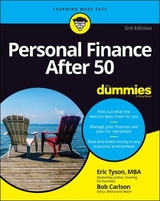
Personal Finance After 50 For Dummies
John Wiley & Sons Inc (Verlag)
978-1-119-54363-3 (ISBN)
- Titel erscheint in neuer Auflage
- Artikel merken
Manage your finances in your golden years—enjoy your retirement!
Numerous life changes come with the territory of getting older—as we're reminded every day by anti-aging campaigns—but one change the media doesn't often mention is the need for a shifting approach to personal financial management. Personal Finance After 50 For Dummies, 2nd Edition offers the targeted information you need to make informed decisions regarding your investments, spending, and how to best protect your wealth. You've worked your whole life for your nest egg—why not manage it as effectively as possible?
Enjoying your golden years hinges on your ability to live the life you've dreamed of, and that's not possible unless you manage your finances accordingly. The right financial decisions may mean the difference between a condo in a more tropical climate and five more years of shoveling snow, so why leave them to chance?
Explore financial advice that's targeted to the needs of your generation
Understand how changes in government programs can impact your retirement
Consider the implications of tax law updates, and how to best protect your assets when filling out tax forms each year
Navigate your saving and investment options, and pick the approaches that best fit the economic environment
Whether you're heading into your senior years or your parents are getting older and you want to help them take care of their finances, Personal Finance After 50 For Dummies, 2nd Edition offers the insight you need to keep financial matters on the right track!
Eric Tyson is a recognized personal finance counselor, writer, and lecturer. Tyson has been featured on and quoted in hundreds of publications and media outlets. Bob Carlson is Chairman of the Board of Trustees of the Fairfax Country Employees' Retirement System.
Introduction 1
About This Book 2
Foolish Assumptions 3
Icons Used in This Book 3
Beyond the Book 4
Where to Go from Here 4
Part 1: Working Toward Retirement 5
Chapter 1: Looking Ahead to Your Future 7
Planning for the Longer Term 8
Identifying long-term planning issues 9
Taking personal responsibility for your financial future 13
Saving and planning sooner and smarter pays off 13
Eyeing Keys to Successful Retirement Planning 16
Saving drives wealth 16
Keeping your balance 17
Understanding that planning is a process 17
Chapter 2: Protecting Your Employment Income and Your Health 19
Assessing Your Need for Life Insurance 20
Understanding the purpose of life insurance 20
Determining your life insurance need 21
Assessing your current life coverage 23
Figuring out what type to buy 25
Choosing where to buy life insurance 26
Protecting Your Employment Income: Disability Insurance 27
Why most people lack disability insurance and why you need it 28
Identifying needed disability coverage 30
Shopping for disability coverage 31
Investing In and Protecting Your Health 33
Take care of your ticker 33
Exercise (and sweat)! 34
Hydrate with good-quality H2O 36
Include fiber in your diet 36
Manage your stress 36
Get your calcium 38
Chapter 3: Developing a Retirement Plan 39
Deciding When to Retire 40
Knowing How Much You Really Need for Retirement 42
Figuring out what portion of income you need 42
Grasping what the numbers mean 43
Eyeing the Components of Your Retirement Plan 44
Social Security retirement benefits 44
Pensions 47
Investments 48
Your home’s equity 50
When Setting Up Your Couples Plan 50
Crunching the Numbers 51
Understanding assumptions and how they work 52
Making the numbers work 54
Dealing with excess money 55
Making Plans for Nonfinancial Matters 56
Personal connections 57
Personal health 57
Activities, hobbies, interests 57
Chapter 4: Identifying Retirement Investments and Strategies 59
Defining Investments 60
Understanding risk 60
Eyeing your returns 63
Considering how investments are susceptible to inflation 64
Being aware of tax consequences 64
Monitoring sensitivity to currency and economic issues 65
What You Need to Do Before You Select and Change Investments 66
Knowing your time horizon 66
Factoring some risk into your investment plan 67
Keeping the bigger picture in mind 67
Allocating your assets 68
Surveying Different Investments 69
Comparing lending investments to ownership investments 69
Looking into stocks 70
Investing in mutual funds and ETFs 72
Comparing investments and risks 76
Managing Investment Portfolios 78
Funds of funds and target-date funds 78
Index and exchange-traded funds 80
Assessing and changing your portfolio 83
Chapter 5: Grasping Retirement Accounts and Their Rules 85
Eyeing the Characteristics of Retirement Accounts 86
Focusing on the tax benefits 86
Being aware of restrictions and penalties 88
Identifying the Different Types of Retirement Accounts 90
Employer-sponsored retirement accounts 90
Self-employed retirement savings plans 90
Individual Retirement Accounts (IRAs) 92
Rolling Over Retirement Balances 93
Deciding what road to take 94
Choosing a custodian and rolling over your balance to an IRA 95
Choosing Beneficiaries for Your Retirement Accounts 98
Taking Required Minimum Distributions, or RMDs 100
Calculating your RMD for an IRA 100
Computing the RMD for other retirement plans 101
Part 2: Making Money Decisions in Retirement 103
Chapter 6: Managing Budgets and Expenses 105
Pointing Out Some Retirement Worries You May Have 106
Running out of money 106
Supporting others 107
Addressing your worries 109
Spending Your Nest Egg 110
Considering the 4 percent rule 110
Naming the factors affecting your use of retirement assets 111
How Spending Really Changes in Retirement 112
Managing Your Expenses 115
Bigger-picture issues 116
Taxes 117
Housing 118
Utilities and communication 120
Food 122
Transportation 122
Personal care and fashion 123
Travel and fun 123
Health care 124
Insurance 124
Children and grandchildren 125
Chapter 7: Guiding Investments and Distributions in Retirement 127
Guiding Your Investments through Retirement 128
Estimating your investment income 128
Rebalancing your investments 130
Looking Closer at Annuities 132
Annuities: A cross between a retirement account and insurance 132
Contributing in your working years 133
Annuitizing in your retirement years 134
Examining the newest annuity 136
Choosing Your Pension Options 137
Selecting between a lump sum or monthly payments 138
Deciding among monthly payment options 143
Eyeing Withdrawal Strategies for Your Investment Accounts 144
Chapter 8: Making Important Housing Decisions 147
Analyzing Moving 148
Considering the pros and cons of moving 148
Eyeing the options for where you can move 150
Tapping Your Home’s Equity: Reverse Mortgages 154
Defining terms and costs 154
Determining whether a reverse mortgage is right for you 156
Searching for more information on reverse mortgages 157
Looking at Tax Issues Regarding Your Housing Decisions 157
Being aware of capital gains exclusion rules 158
Converting your home to a rental: Yes or no? 158
Chapter 9: Considering Your Long-Term Care Insurance Needs and Options 161
Understanding Long-Term Care 162
Naming the types of long-term care 162
Predicting who will need long-term care 164
Estimating how much long-term care will cost 166
Planning to Pay for LTC 169
Considering LTC Insurance 170
Knowing the basic features of LTCI 171
Checking out two more important LTCI factors 178
Using Hybrid Insurance Products 180
Exploring annuities to finance LTC 181
Financing LTC with life insurance 182
Assessing the LTC hybrids 183
Financing LTC Yourself 184
Figuring out whether you can finance your own LTC 184
Deciding when to buy LTCI 187
Comparing tax-qualified and nonqualified policies 188
Opting for life insurance instead of LTCI 190
Taking advantage of the reverse mortgage 191
Evaluating Employer and Group Coverage 192
Combining LTCI and Self Insurance 193
Part 3: Dealing with Government Programs 195
Chapter 10: Making Your Best Choices under Social Security 197
The Lowdown on Social Security 198
Determining When You’re Eligible for Benefits 200
Reviewing your earnings history 201
Defining when you can retire 203
Taking a Closer Look at Spouses’ and Survivor Benefits 207
Understanding the choices for spousal benefits 208
Ensuring spouses are taken care of: Survivor’s benefits 211
Identifying When You May Need to Receive Benefits 214
What are your cash flow needs? 215
Will waiting pay off? 215
What other income do you have? 217
Do you want to continue to work? 217
What are the potential income taxes on benefits? 218
What’s your life expectancy? 218
Noting How Working Reduces Benefits 219
Taking the penalty for exceeding the annual income limit 219
Determining the penalty on a monthly basis 220
The penalty isn’t always bad 221
Preserving Your Benefits 222
Deferring income 222
Using your corporation 223
Considering exempt income 224
Relying on special income 225
Being Aware of Potential Income Taxes on Your Benefits 226
Understanding how modified adjusted gross income works 226
Reducing taxes on benefits 228
Changing Your Mind: A Do-Over 231
Deciding whether you should take a do-over 232
Doing the do-over 232
Looking at What the Future Holds for Social Security 233
Chapter 11: Getting the Most Out of Medicare 237
Starting Medicare: A Broad Overview of Enrollment Deadlines 238
Understanding Part A 240
Seeing who’s eligible and signing up for Part A 241
Defining Part A coverage 243
Exploring Parts B and C 245
Scoping out Part B 246
Probing Part C: Medicare Advantage 252
Qualifying for Prescription Drug Coverage with Part D 257
Examining Part D plans 258
Enrolling in a Part D plan 264
Eyeing a Medicare Supplement 266
Understanding Medigap policies 266
Standardizing Medigap policies 267
Choosing a Medigap policy 269
Obtaining quotes for Medigap insurance 271
Resolving Some Sticky Issues 272
Changing plans 272
Monitoring changes at work 273
Making a foreign move 274
Chapter 12: The State Health Care System Backup: Medicaid 275
Discovering What Medicaid Is 276
Considering Medicaid Eligibility 277
Establishing Functional Eligibility 277
Meeting Financial Requirements 278
Understanding income limits 279
Understanding asset limits 281
Examining Planning Strategies 291
Spending down 292
Creating a life estate 292
Setting up trusts 293
Buying an immediate annuity 296
Going the spousal refusal route 297
Recognizing the downsides of Medicaid eligibility strategies 298
Using Both Medicare and Medicaid 299
Eyeing Reasons Not to Seek Medicaid 300
Part 4: Estate Planning: It’s More Than Just Dead People and Lawyers 303
Chapter 13: The Basics on Estate Planning 305
Understanding Estate Planning 306
Studying Some Strategies Before Starting Your Estate Plan 310
Finish your plan no matter what 310
Keep track of your estate 311
Estimate cash flow 312
Don’t wait for the perfect plan 313
Carefully choose executors and trustees 313
Anticipate conflicts 314
Answering Key Questions to Gather Critical Information 315
Who’s in charge? 316
How much should I give now? 316
Should I apply controls and incentives? 317
Should heirs get equal shares? 318
Should I exclude someone? 319
How should my blended family be handled? 319
Should I leave only money? 320
Should my wealth stay in the family? 321
Knowing How Estate Taxes Work 321
Reviewing the estate tax 322
Considering state taxes 323
Finding Good, Affordable Advice 325
Doing it yourself 325
Using an expert: Yes or no? 326
Chapter 14: Eyeing Wills and Other Legal Documents 329
Writing Your Will 329
Pointing out some important details 330
Facing the limits of wills 335
Excluding family members 336
Avoiding things you can’t do with your will 336
Assigning a Financial Power of Attorney 337
Recognizing the importance of a POA 338
Choosing the right POA 339
Delegating Medical Decisions 340
Understanding living wills 341
Signing DNRs 342
Assigning a health care proxy or POA 343
Authorizing HIPAA 344
Combining documents 344
Passing Other Assets 344
Naming beneficiaries for your assets 345
Examining the special case of IRAs 345
Looking Closer at Probate 348
Avoiding probate: Yeah or nay? 349
Considering joint tenancy 349
Making use of living trusts 351
Chapter 15: Tackling the Federal Estate Tax When You Have Too Much Money 355
Understanding the Estate Tax 356
Examining how your estate tax is calculated 357
Decreasing your estate taxes 359
Tallying Your Assets 359
Making sure you don’t overlook certain factors 360
Assessing included assets 360
Reducing Your Estate 363
Considering strategies to lower your estate’s value 363
Maximizing tax-free gifts 367
Taking Deductions 371
Looking at the marital deduction 371
Understanding portability of the lifetime exemption 372
Giving charitable gifts 373
Choosing Family Estate Strategies 375
Equalizing estates 375
Using the bypass trust 376
Taking advantage of marital deduction trusts 377
Putting the strategies together 378
Contemplating Life Insurance 380
Paying obligations with life insurance 380
Purchasing life insurance to enhance inheritances 381
Avoiding the Tax on Gifts to Grandkids: The GSTT 382
Chapter 16: Focusing on Estate Taxes and the Many Types of Trusts 385
Identifying the Cast of Characters 386
Naming the Types of Trusts 387
Looking at when trusts take effect 388
Revoking or retaining rights 388
Determining how income is distributed 389
Addressing the trustee’s powers 390
Using Trusts in Estate Planning 391
Donating to charity with charitable trusts 392
Opting for retained income trusts 394
Taking care of special needs with SNTs 395
Spreading the wealth through dynasty trusts 397
Creating life insurance trusts 398
Part 5: The Part of Tens 401
Chapter 17: Ten Common Retirement and Estate Planning Mistakes 403
Not Having at Least a Basic Financial Plan 404
Procrastinating about Estate Planning 404
Underestimating Life Expectancy 406
Miscalculating Inflation 407
Believing You’ll Retire When You Expected To 408
Ignoring Nonfinancial Planning 409
Failing to Coordinate with Your Spouse 410
Expecting to Age in Place 411
Thinking Most Medical Expenses Will Be Covered 412
Missing the Initial Enrollment for Medicare Plans 413
Chapter 18: Ten Things to Know about Working in Retirement 415
Some Work Is Good for You 416
The Social Security (Tax) Impact Can Be Huge 417
Number Crunching Can Show You How Different Scenarios Work 418
Life Is Short and You Owe It to Yourself to Do What You Love 418
Investing in Education Can Boost Your Employment Value 419
Some Employers Are More User-Friendly for Older Workers 419
Taking Some Employment Risk Is Important 420
Starting/Buying a Small Business May
Be a Rewarding Option 420
Your Spouse May Not Want What You Want 421
Volunteering Makes You Happy and Benefits Your Community 421
Chapter 19: Ten (or So) Tips to Know about Caring for Your Aging Parents 423
Leverage Off Others’ Experiences 424
Ask for Professional Help 424
Invest in Their Health 425
Get Your Parents’ Affairs in Order 425
Examine Housing and Medical Care Options 426
Use Caregiver Agreements 426
Separate Living Spaces if Parents Are Going to Move In 427
Take Care of Your Family 428
Take Care of Yourself 428
Index 429
| Erscheinungsdatum | 31.08.2018 |
|---|---|
| Verlagsort | New York |
| Sprache | englisch |
| Maße | 188 x 234 mm |
| Gewicht | 638 g |
| Themenwelt | Sachbuch/Ratgeber ► Beruf / Finanzen / Recht / Wirtschaft ► Geld / Bank / Börse |
| Wirtschaft ► Allgemeines / Lexika | |
| Wirtschaft ► Betriebswirtschaft / Management ► Finanzierung | |
| ISBN-10 | 1-119-54363-0 / 1119543630 |
| ISBN-13 | 978-1-119-54363-3 / 9781119543633 |
| Zustand | Neuware |
| Informationen gemäß Produktsicherheitsverordnung (GPSR) | |
| Haben Sie eine Frage zum Produkt? |
aus dem Bereich



